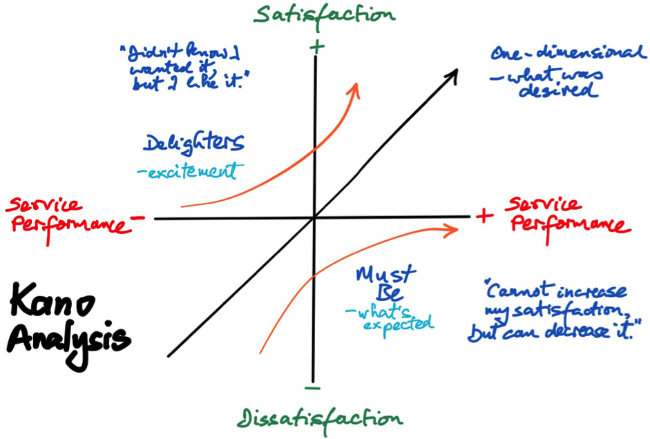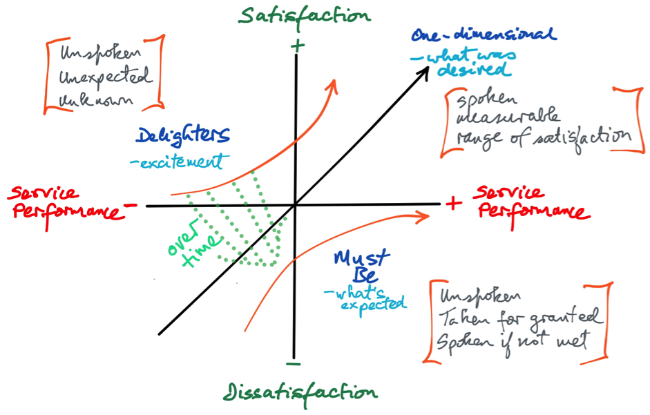Agile notes on - Kano Analysis
Before we start… ‘customer’
I always want to make sure we are clear on what we mean by ‘customer’… and in what context we use this word.
The ‘customer’ concept can cause some controversy when used in higher education and so when we use it we are referring to customers of the support ecosystem in the university – we are not using it in relation to teaching and research. Much as been written on the subject but, in essence, students are not consumers of teaching and learning is not a product. The support ecosystem, again in essence, is the supportive environment created by those activities of the university which make education and research possible .
A customer is someone whose needs you understand, and in relation to which you understand what you have to offer, and it is in the dialogue between what they need and what you have to offer that you shape the future together. Customers draw your attention to ‘why?’ and ‘what for?’ You look at what you can do or could do in terms of their needs. Where there’s a gap between what they need and what you have to offer a creative dynamic takes place, which shapes and changes you both. By the way, customers can be colleagues and colleagues can be customers.
What is Kano analysis used for?
How do you analyse what your customers need? How can you easily determine what will delight your customers or what their basic needs are? One technique from Lean Six Sigma is the Kano Analysis, based on the idea that for some requirements, customer satisfaction is proportional to the extent to which the process or service is fully functional.
Kano analysis looks at three types of requirements
- Those that satisfy basic needs – these must be met for your customers to say that the process/service works
- Those that satisfy performance needs – the more you meet these the better the customers will appreciate what you have done and see the process/service as performing well
- Those that satisfy excitement needs – if you meet these you get an excited “that’s really good!” reaction
Dissatisfiers or Basic Needs
Expected features or characteristics of a process or service (correct data, accessible systems, intelligible forms, informed staff). These are typically ‘unspoken’ and are taken as a given. If you do not meet these needs customers will be very dissatisfied and you will get plenty of complaints and grumbling. When you book a teaching room, chairs for the students are a given – you do not expect to need to ask for them. If a basic need is not met your customers will be extremely dissatisfied.
Satisfiers or Performance Needs
Standard features or characteristics that increase the better you deliver them or decrease satisfaction if they are not strong – ease of use, speed, efficiency. These needs are typically ‘spoken’ – if you ask your customers what they want they will tell you these things. Taking the room booking example, the easier it is to search for a room the happier the customer will be. Booking the room yourself when you find it is better still.
Delighters or Excitement Needs
Unexpected features or characteristics that impress your customers and earn you ‘extra credit’. These are typically ‘unspoken’ largely because the customer had not imagined them or thought them possible. Showing 360 degree photos of rooms, swapping booked rooms, booking sequences of slots in a room… the ‘delighters’ are driven by your imagination and drawing them out of your customers in creative ways.

Which of your customers’ needs are you going to meet – and how will they feel?
The horizontal axis of this figure shows how fully functional a process or service is. The vertical axis indicates how satisfied the customer is going to be. The line going through the origin at 45 degrees where customer satisfaction is directly proportional to how fully functional the process or service is. This is the ‘more is better’ line – more functionality is seen as better. Anything to the left of the origin means that while the functionality is important it will not make the customer happy – you need to reach the cross overpoint for at least some happiness in your customers.
There is another question you can ask – how much effort/investment is needed to hit a given point of happiness/functionality? This is an important question. No matter how much you invest in polishing the “must be’s” they will not add to customer satisfaction – you will get no credit for them. A ‘delighter’ which does not require too much effort can be a nice bonus. When faced with prioritising potential developments, adding an ‘effort/investment’ annotation to the Kano Analysis helps focus where your effort may deliver the best return on investment.
How do you use a Kano Analysis?

Step 1: Ask your customers what they want if you want to know what will satisfy them.
You really need to ask your customers what they want if you want to make sure you meet at least some of their needs. The problem is, they will not necessarily voice all their needs (the “must be’s”) and they are not likely to identify the unexpected!
If you are just trusting your own wisdom and insight… recognise this as a limitation.
Step 2: Draw the Kano map on a flipchart or white board or writable wall
Step 3: Write the elements of the service or process you are looking at on Postits
Step 4: Place the postits on the map as you think fit
Ideally you are doing this with a group, even more ideally one which has some of your customers as members. Start to tease out just where a given element of the service or process fits.
You can use this as a kind of brainstorming – everyone does their own postits, places them on the map, and then you have a group discussion.
Now you can start to make calls on the value and importance of a given element of the process or service.
When you have done the satisfaction/service map you can also try the satisfaction/investment map. The first answers ‘what do I need to provide to make my customers happy?’ and the second answers ‘what investment do I need to make them happy?’
Kano Requirements Type Definitions: A Summary
| Must Be (Expected Quality) | Requirement that can dissatisfy (expected, but cannot increase satisfaction) |
|---|---|
| One-Dimensional (Desired Quality) |
The more of these requirements that are met, the more a client is satisfied |
| Delighters (Excited Quality) | If the requirement is absent, it does not cause dissatisfaction, but it will delight clients if present |
Indifferent |
Client is indifferent to whether the feature is present or not |
| Reverse | Feature actually causes dissatisfaction |
Here is the Kano Analysis in summary
The Kano analysis helps prioritise customer needs.
It helps to identify unspoken needs before prioritisation.
It helps recognise that a system which only meets basic needs will not make customers happy.
It should be linked to your longer term commitment to your customer.
The first iteration of what you do must cover the “must be’s”… though delight is a lubricant in happy relationships
Your customers’ expectations and/or needs vary over time.
Delighters can quickly become “must be’s”
Conclusion: What Delights Today…
Needs change. For example, being able to book rooms online some becomes a given, being able to search becomes a basic requirement, being able to see the room layout a necessity. What next? Being able to book catering along with the room? Being able to release your room online? Being able to book parking passes for guests coming for a seminar in a room you are hiring?
The important points to keep in mind are
what delighted customers in the past quickly becomes expected and
what is expected today will not meet minimum customer expectations in the future.
Most of all, do not forget your customers. You are trying to understand their needs, figure out what you can do in response, meet the obligations on you, and educate both parties at the same time. Have you ever been involved in the following? A group of colleagues from different areas to come together to decide on how a newly necessary system or process should be designed and, because of the variety of their backgrounds, they can feel they know what is needed and, perhaps, they do not feel they have time to check with the customers. At a recent session using a Kano Analysis we populated the map quite well and had a particularly interesting conversation on what fitted into the ‘must be’ category. We produced a really detailed Kano diagram with lots of useful insight. “How would your customers populate the same map?” Silence. They were confident in understanding their own perspective but did not, as it turned out, have the same confidence at all when it came to what would make their customers happy. They were designing a system which would be in wide use, with high profile, and likely to be the subject of criticism for any flaws it contained. They had not checked with the customers and did not know, most importantly, what their “must be’s” must be.
Bottom line – customers are really good at knowing what will make them unhappy. Check.
Published on 13 February 2020